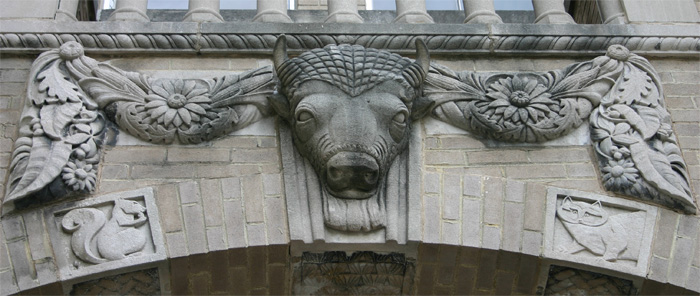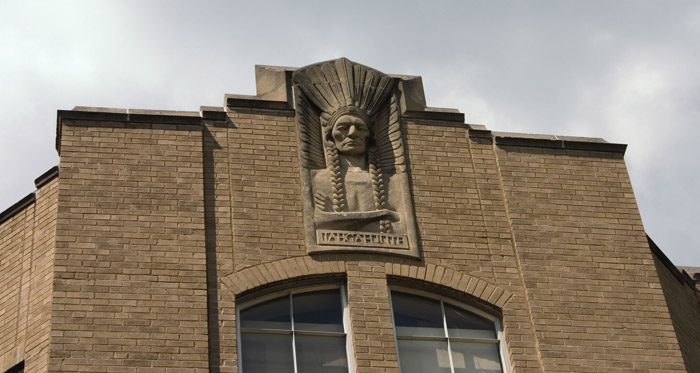
Smith's building was Gothic Revival meets Art Deco. The shapes and forms are out of Medieval Europe but the clean lines, verticality, streamlining, and stylized figures are Art Deco. The ornament on Indianola spoke to the school's name and incorporated Native American and woodland themes. The school's main entrance is surround with carvings of owls, racoons, squirrels, and other woodland creatures and surmounted with a buffalo head. Ceramic tiles of native woodland plants and trees decorate the exterior walls. Over all, the head of a feather-bonneted Native American warrior stares down on the main entrance. The building was designed in a C-shape surrounding a richly planted courtyard with trees, flowers, and ornamental bushes. Other amenities included skylights in the lunch room and an wood-paneled library with a stone fireplace. |
|
Ohio sculptor Erwin F. Frey (1892-1967) carved the sculptures for the project. Frey was also responsible for the large bronze statue of William Oxley Thompson in front of Ohio State's Main Library. |
|
The sculpture above the entrance depicts Ohio Mingo chief Tahgahjute (1725-80), better known as Chief Logan. Logan's Lament, a speech mourning the slaughter of his family by white settlers, was saved for posterity by Thomas Jefferson and considered a masterpiece of American rhetoric. Along with the Gettysburg Address, it was memorized by generations of American schoolchildren. In a February 1935 issue of the school magazine/yearbook, The Indianola Echo, students wrote of the chief:
The new school preserved much of Indianola Park's picnic grounds as a play and recreation area for students. As many of the old trees as possible were saved. Some of them are still there today. The ravine along the railroad tracks was mostly left intact. Indianola Park's "Picnic Valley" became Indianola Junior High School's "The Hollow." In the 1930s and 40s, "The Hollow" was the staging area for the school's annual May Pageant and hosted a few school productions of "A Midsummer's Night Dream" and other Shakespeare plays. Indianola students in the 1930s must have thought it terrifically novel to have an amusement park next door to their school but history doesn't record much about interactions between the school and the park. One possible area of interaction was the pool. Indianola's swim team in the 1930s was a contender for city championships but the school doesn't have a pool. It's possible they practiced at the park but there's no record of it. |
![]()


